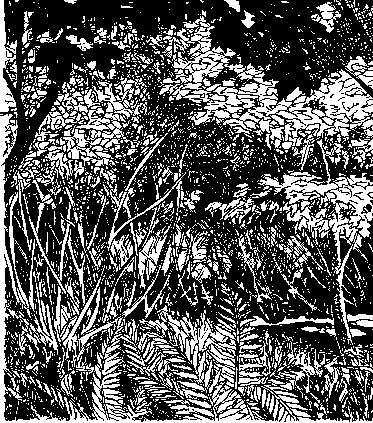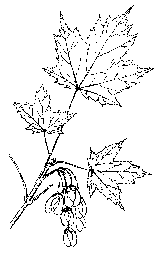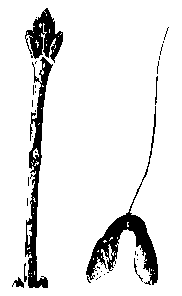
Eastern Habitat Joint Venture
 What might appear as a sprawling tangled mess is nature's idea of productivity. Swamps, one of nature's most biologically productive habitats, are too busy to be tidy. Inside a swamp is like a traffic jam - trees, shrubs, ferns, mosses, frogs, insects and birds collide all over the place. But amongst this jumble, critical work is accomplished. Plant and animal food is produced in huge quantities, young wildlife nurtured, rare species supported and environmental stability is maintained. Swamps don't need any outside help with organisation; they're best left alone to go about their own busy way.
What might appear as a sprawling tangled mess is nature's idea of productivity. Swamps, one of nature's most biologically productive habitats, are too busy to be tidy. Inside a swamp is like a traffic jam - trees, shrubs, ferns, mosses, frogs, insects and birds collide all over the place. But amongst this jumble, critical work is accomplished. Plant and animal food is produced in huge quantities, young wildlife nurtured, rare species supported and environmental stability is maintained. Swamps don't need any outside help with organisation; they're best left alone to go about their own busy way.
Swamps are similar to freshwater marshes in form and function. They develop in depressions surrounded by higher ground and can either be wet like marshes or merely waterlogged. The main distinction between marshes and swamps is water level. In Nova Scotia, marshes tend to be covered with standing water throughout most of the year whereas swamps are normally just moist on the surface. Swamps regularly form where seasonal flooding occurs, such as at the edge of ponds and lakes, and along borders of streams and rivers. Low lying areas with nearby ground seepage and springs also tend to develop into swamps.
Two general types of swamp exist in Nova Scotia: shrub swamps and wooded swamps.
Shrub swamps are permanently or seasonally flooded areas. Dominant plants are tall bushes like alder, and low bushy shrubs like sweet gale and rhodora.
Beneath this shrubby vegetation, grasses are the main ground cover. Mosses and ferns, particularly cinnamon fern and royal fern, are other common plants. Over time, shrub swamps tend to evolve into wooded swamps.
Royal fern  |
Wooded swamps usually experience flooding during spring and fall and tend not to be as wet as shrub swamps. Because the soil of a wooded swamp is not constantly waterlogged, deciduous and coniferous trees such as red maple, black spruce and balsam fir are able to establish themselves. Shrubs flourish in wetter spots within a wooded swamp.
Wildlife of swamps
Swamps, like their marshy counterparts, are nutrient-rich environments that support a wide variety of wildlife. Biologically, swamps are some of the most productive habitats. Seepage from surrounding lands, and spring flooding of nearby streams and lakes assure that swamps are constantly supplied with nutrients.
Red maple   |
The swamp's rich mucky soils provide ideal habitat for wood frogs, snails, water shrews, red maples and a wide array of plants.
Many species of bird, including swamp sparrow, common yellow throat, swallows, warblers, and nighthawk feed on the assortment of seeds, fruits and insects contained in a swamp. The tangle of trees, shrubs and plants serve as ideal nesting cover for many birds, including the colourful wood duck. Bats, bears, snowshoe hare and white-tail deer frequently venture into swamps in search of food.
Swamps and the environment
Swamps are important sites of energy transformation. Working like power plants, swamps convert basic minerals and nutrients into food energy for micro-organisms, plants and animals. In this way, swamps fuel the food chain for wildlife.
Swamps serve as storage areas for water, as do all wetlands, and assist the environment by filtering out contaminants from surface waters so that the groundwater supplies remain pure.
Conservation A swamp's jumble of shrubs, trees, moss and muck often isn't as endearing to people as it is to wildlife. Swamps, because they are usually damp instead of wet, are easy targets for filling, land development, and even dumping.
Activities such as forestry, agriculture or land development can potentially alter local water levels and irreversibly damage nearby swamps.
Helping swamps...
|
It is important to recognise that swamps are productive habitats in nature. Though they may not be every person's vision of beauty, in the eyes of wildlife, swamps are the picture of bounty.
 |
 |